| |
|
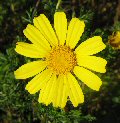 | |
| MaltaWildPlants.com by Stephen Mifsud |

|
| |
|
|
 |  |  |  |
| External Links: |
|
Borago officinalis (Common Borage) |

Borago officinalis (BORAGINACEAE.)
Images for this profile are taken from the Maltese Islands after year 2000. |
|
| Nomenclature |
Species name : | Borago officinalis L. | Authority : | Carl von Linne, Sweden, (1707 - 1778) | Synonyms :
(basionym or principal syn.) |
|
Plant Family : | | English name(s) : | Common Borage, Common Bugloss, Burrage | Maltese name(s) : | Fidloqqom | Status for Malta : | Indigenous. Present on the Maltese islands before man | Name Derivation : |
Borago: ancient name of unknown origin, possibly derived from the Latin word Borra which means rough hair with reference to the stiff hairs the Borago species possess. (Latin origin ); 2 = ancient name of unknown origin, also possibly derived from the Latin word "Borra" which means rough hair with reference to the stiff hairs the Borago species possess.(Latin);.
officinalis: Commercially or 'officially' used and sold in shops for medicinal or healing applications. This epithet was given in the past to plants with well-known medicinal properties. (Latin origin ); 2 = Having an official medicinal or pharmacological use and so sold as a medicinal herb (Latin).
| Remarks : | |
|
| Morphology and structure |
PLANT STRUCTURE: |
Character | Growth Form | Branching | Surface |
Description | | | |
General
Picture |  |  | 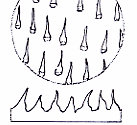 |
|
LEAVES: |
Character | Arrangement | Attachment | Venation |
Description | | | |
General
Picture |  | 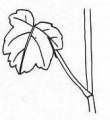 |  |
| |
Character | Leaf Shape | Leaf Margin | Remarks |
Description | | | |
General
Picture |  | 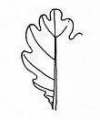 |  |
|
FLOWERS: |
Character | Colour | Basic Flower Type | No. of Petals | No. of Sepals |
Description | Blue with tinge of indigo (with white and black center). | | 5 | 5 |
General
Picture | | 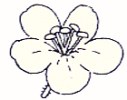 |  |  |
| |
Character | Inflorescence | Description | Ovary | Stamens |
Description | | The corolla consists of 5 blue-indigo petals which are fused together at the base forming a shape of a star. The location where petals fuse is white hence forming a white cente. reproductive organs include 5 black long stamens which group together and project out as if they are a single, central, tapering conical structure and a single style coming from a hidden green ovary. | | |
General
Picture |  |  | 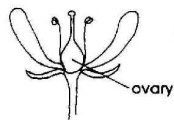 | 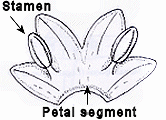 |
| |
Character | Scent | Average Flower Size | Pollen Colour | Other Notes |
Description | None | 22mm | White / Pale Yellow | - |
|
SEEDS: |
Character | No. Per Fruit | Shape | Size | Colour |
Description | 4 | Tooth-shaped Cylindrical with one end flat and attached in sockets in the receptacle and the apical end being rounded or pointed. They have a hard wrinkled texture. | 8mm long | Black |
General
Picture |  |  |  |  |
|
FRUIT AND OTHER BOTANICAL DATA: |
Character | Fruit Type | Colour of Fruit | Subterranean Parts | Other Notes |
Description | | Pale green (referring to the covering sepals) | | Bristles on the flower stalks and sepals These bristles are interesting since they are colourles (as if made of glass) with a deep red basal swelling. In sepals the swelling turns to a deep blue colour (or just green) when the flower drops off and seeds starts developing. |
General
Picture |  |  |  |  |
|
|
| Plant description and characters | |
Life Cycle: | Annual. |
Growth Form: | THEROPHYTE (annual plants, herbaceous) |
Habitat: | Cultivated ground, beside field walls, uncropped fields and often along waysides. |
Frequency: | Very Common |
Localities in Malta: | Very Common everywhere especially at places near fields such as Mistra, Buskett and Dingli and most valleys in Malta and Gozo. |
Plant Height: | 30-70cm. |
| Dec-May |
Protection in Malta: | Not legally protected till the last update of this website (2/Mar/2022) |
Red List 1989: | Not listed in the Red Data Book of the Maltese Islands |
Poison: | |
The plant is erect, grows up to 50-75cm high and is covered by numerous, white or more precisely translucent stiff bristles, of various length ranging from 1 to 3mm. Initially, the plant forms a basal rosette of large long-petiolated leaves but later it develelops an erect, thick, flowering stem which forms several smaller alternate branches and leaves. New shoots grow at the leaf axils.
The morphology of the leaves differs between the basal adault leaves and the young cauline (stem-borne) leaves. The basal leaves are about 120 - 150mm long, stalked (with two small basal lobes embracing stem) ovoid in shape and have a wavy (undulate) outline. The younger leaves are smaller, not more from 100mm long, lanceolate shape, sessile or with a short petiole and with a dentate outline. Both types of leaves have several prickly bristles, but not as much as in the stem or calyx. Despite the protective bristles, the leaves are still observed eaten by certain herbivores like snails and caterpillars.
The branching stems ends up into a raceme of several elegant light blue, star-shaped flowers that are found hanging upside-down. Each flower is made up of 5 free sepals and 5 petals. They measure 20-25mm across. The sepals are narrow, spreading out and densely covered with bristles of different sized, many of which have a reddish swollen base. The overall colour of the sepals is usually reddish-brown, but sometimes they are green. The petals are fused together at the basal part with the upper halves free and hence forming a star-shaped corolla. The central part is white and columnar, through which 5 prominent black (with a purple tinge) stamens protrudes out. The stamens, although being seperate, are closely grouped together forming an elongated conical structure. Hidden within is the green, inconspicuous pistil. The pollen is pale yellow and not much visible from the exterior, since the opening is facing inside at the core of the stamen cluster. Self pollination is hence feasible.
When the life span of the flower is over, the corolla drops off and the sepals close up to form pot-shaped structure, covering and protecting the fruit inside. The fruit simply consists of 4 bare seeds known as nutlets, sitting in cavities of a common receptacle. When the nutlets are ripe, they become dark-brown to black in colour and simply fall off without any mechanical dispersion. Sometimes they drop pre-maturely and continue to mature on the ground.
|
|
| Information, uses and other details |
There is so much information about this plant that it is impossible to gather them into one document. As a matter of fact, the vast information shown here is a small collection of summarized reports. To facilitate the navigation and reading of the huge information content below, you can use the following menu of the main sub-titles. Click on the sub-title links below:
- Origin
- Derivation of the plant's Genus name - Bor(r)ago
- History and old reports
- Cultivation + Propagation details
- Edible Uses
- Constituents and Active components
- Medicinal Uses
- The importance of the Borage Seed Oil
- Borage used against Cancer
- Other Uses
- Known Hazards and Toxic properties
Origin
The Common Borage is believed to have originated in Aleppo, a city in northwestern Syria. [WWW-50] but now naturalized in most parts of Europe and North Africa. [WWW-03] It grows in the Mediterranean countries and is cultivated elsewhere. Native to Europe, Asia Minor, and North Africa and has spread to North America. [WWW-50]
Derivation of the Plant's Genus Name - Bor(r)ago
Nomenclature
Borage was sometimes called Bugloss by the old herbalists, a name that properly belongs to Anchusa officinalis, the Alkanet, the Small Bugloss being Lycopsis arvensis, and Viper's Bugloss being the popular name for Echium vulgare.
Some authorities consider that the Latin name Borago, from which our popular name is taken, is a corruption of corago, from 'cor', the heart, and 'ago', I bring, because of its cordial effect.
In all the countries bordering the Mediterranean, where it is plentiful, it is spelt with a double 'r,' so the word may be derived from the Italian 'borra', French 'bourra', signifying hair or wool, words which in their turn are derived from the Low Latin 'burra', a flock of wool, in reference to the thick covering of short hair which clothes the whole plant.
Other sayings (ref. Henslow) suggests that the name is derived from 'barrach', a Celtic word meaning 'a man of courage.' [WWW-03]
Ancient Celtic warriors drank wine with borage to give them courage before going into battle. Called Langue de Boeuf and also bugloss, one signifies Ox-tongue in Greek, and the other signifies the same in French. [WWW-50]
Similar information was found on [WWW-51] which says name borage is often said to come from the Latin cor ("heart") and ago ("I stimulate"), but in a less picturesque reality, it is probably derived from the Latin borra, meaning "hair of the beast" and referring to its bristly leaves.
History and old reports
The 1st-century Roman Pliny calls it Euphrosinum, because it maketh a man merry and joyfull: which thing also the old verse concerning Borage doth testifie:
"Ego Borago" - (I, Borage)
"Gaudia semper ago". - (Bring alwaies courage.) [WWW-03]
He claimed that borage steeped in a wine, was the famous Nepenthe of Homer, which brought absolute forgiveness when drunk. The herb is still often called "cool-tankard" in England, where an old verse relates: To enliven the sad with a joy of a joke, give the wine with some borage put in to soak". [WWW-51]
Those of our time do use the flowers in salads to exhilarate and make the mind glad. There be also many things made of these used everywhere for the comfort of the heart, for the driving away of sorrow and increasing the joy of the minde. The leaves and floures of Borage put into wine make men and women glad and merry and drive away all sadness, dulnesse and melancholy, as Dios corides and Pliny affirme. Syrup made of the flowers of Borage comforteth the heart, purgeth melancholy and quieteth the phrenticke and lunaticke person. The leaves eaten raw ingender good bloud, especially in those that have been lately sicke.' [WWW-03]
John Evelyn (a diarist), writing at the close of the seventeenth century tells us: 'Sprigs of Borage are of known virtue to revive the hypochrondriac and cheer the hard student.' [WWW-03]
Parkinson commends it 'to expel pensiveness and melanchollie.' Bacon says that it 'hath an excellent spirit to repress the fuliginous vapour of dusky melancholie.' Culpepper finds the plant useful in putrid and pestilential fever, the venom of serpents, jaundice, consumption, sore throat, and rheumatism.' [WWW-03] Gerard recommended its use 'to exhilarate and make the mind glad ... and drive away all sadnesse, dulnesse and melancholy', and said that 'a syrup made of the flowers of borage comforteth the heart, purgeth melancholy, and quieteth the phreneticke or lunaticke person'. [WWW-56]
In the early part of the nineteenth century, the young tops of Borage were still sometimes boiled as a pot-herb, and the young leaves were formerly considered good in salads. [WWW-03]
In ancient times and in the Middle Ages, borage was known for its cooling quality and refreshing flavor and was said to make men merry. Also referred to as the "herb of courage". In medieval times, borage tea was given to competitors in tournaments as a moral booster.
[WWW-50]
Cultivation and Propagation Details
A very easily grown plant, succeeding in ordinary garden soil[1], preferring a dry soil[37] and a sunny position[138]. It grows particularly well in loose, stony soils with some chalk and sand[244]. Plants are tolerant of poor dry soils, though much bigger specimens are produced when the plants are growing in better conditions[238]. Tolerates a pH in the range 4.8 to 8.3.
Borage is often grown as a culinary plant in the herb garden[1, 7]. Although an annual, it usually maintains itself by self-sowing, sometimes in quite a prolific manner, as long as the soil is disturbed by hoeing etc[14, 188].
Plants often develop mildew when growing in dry conditions or towards the end of the growing season[238].
Flowers are a deeper blue when grown in poorer soils[138]. Unfortunately, the seed ripens intermittently over a period of time and fall from the plant when it is ripe, this makes harvesting the seeds in quantity very difficult. Will accept partial shade.[WWW-51]
Borage is not a fussy plant, but the richer the soil, the bushier the plant will be. It prefers full sun, and needs protection from wind as it is easily blown over. Seeds can be sown throughout the season, and once growth is established, it will continue to seed itself. Place plants close together so they can support each other. A plant or two in an indoor pot will provide leaves all winter, but it will need lots of sun. [WWW-55]
Propagation:
Seed - sow April/May in situ. The plants quickly develop a stout tap-root and do not transplant successfully [238]. The seed can also be sown in situ in the autumn, this will produce larger plants and earlier flowering[4]. The plant usually self-sows prolifically [KF].
Borage flourishes in ordinary soil. It may be propagated by division of rootstocks in spring and by putting cuttings of shoots in sandy soil in a cold frame in summer and autumn, or from seeds sown in fairly good, light soil, from the middle of March to May, in drills 18 inches apart, the seedlings being thinned out to about 15 inches apart in the rows. If left alone, Borage will seed itself freely and comes up year after year in the same place. Seeds may also be sown in the autumn. Those sown then will flower in May, whereas those sown in the spring will not flower till June. [WWW-03]
Edible Uses
Leaves are used to be eaten raw or cooked [2, 5, 7, 14, 115, 183]. They can be used as a pot-herb or be added to salads [4]. They are also added whole as a flavouring to various drinks such as Pimms and wine-based drinks [238]. The leaves are rich in potassium and calcium, they have a salty cucumber flavour [200]. Very hairy, the whole leaves have an unpleasant feeling in the mouth and so they are best chopped up finely and added to other leaves when eaten in a salad [KF]. The leaves should always be used fresh, because they lose their flavour and colour if dried [244].
Flowers can be eaten raw. They are used as a decorative garnish on salads and summer fruit drinks [2, 5, 7, 14, 183]. The flowers are very nice, both to look at and to taste with a sweet slightly cucumber-like flavour [KF, SM].
A refreshing tea is made from the leaves and/or the flowers [21, 183].
The dried stems are used for flavouring beverages[183].
The seed yields 30% oil, 20% of which is gamma-linolenic acid[141]. Total yields are 0.35 - 0.65 tonnes per hectare[141]. Unfortunately, the seed ripens intermittently over a period of time and falls from the plant when it is ripe, this makes harvesting the seeds in quantity very difficult[KF].
An edible blue dye can be obtained from the flowers. It is used to colour vinegar which turn pink in acid environment [183].
The fresh herb has a cucumber-like fragrance. When steeped in water, it imparts a coolness to it and a faint cucumber flavour, and compounded with lemon and sugar in wine, and water, it makes a refreshing and restorative summer drink. It was formerly always an ingredient in cool tankards of wine and cider, and is still largely used in claret cup. Our grandmothers preserved the flowers and candied them. [WWW-03]
The cucumber-flavored leaves can be used in casseroles, or added to salads, but the leaves are very hairy and have an unpleasant feeling in the mouth and so they are best chopped up finely and added to other leaves when eaten in a salad. They are also added whole as a flavoring to various drinks such as Pimms and wine-based drinks. The fresh flowers are delicious and used to decorate salads, or floated on a cold soup or punch. The can also be crystallized into candy. [WWW-51]
Edible uses according to [WWW-55] are summarized as follows :
- Borage flowers and leaves are the traditional decoration for gin-based summer cocktails, and may be set in ice cubes to garnish other drinks.
- The flowers and young leaves may be used to garnish salads. dips, and cucumber soups.
- Candied borage flowers make attractive cake decorations.
- Chopped leaves can be added to soups and stews during the last few minutes of cooking.
- The leaves can be cooked with cabbage leaves (two parts cabbage, one part borage.)
- Borage does not dry well for culinary use.
Constituents and Active components
Active Compounds according to [WWW-08]:
Pyrrolizidine alkaloids, including lycopsamine, intermedine and their acetyl derivatives, with amabiline and supinine.
Choline, but Allantoin is reported to be absent
Reference [WWW-52] states that the plant contains the following important constituents in the indicate parts:
- Acids: acetic, lactic ( plant) ascorbic, nicotinic ( leaves )
- Sugars: arabinose, galactose ( Plant)
- Vitamins: ( beta-carotene) , Vitamin C (ascorbic- acid), Choline ( leaves)
- Minerals: Calcium, iron, magnesium and phosphorous ( leaves) cobalt ( plant)
- Fiber ( plant )
- Mucilage (plant)
- Tannins (plant)
- Alkaloids (plant ) [WWW-52]
The plant is rich in potassium and calcium. [WWW-51, WWW-03] and possess mucilage, tannin, traces of essential oil, while the seeds are rich in Gamma Linolenic Acid (GLA). [WWW-50]
Borage contains potassium and calcium, combined with mineral acids. The fresh juice affords 30 per cent, the dried herb 3 per cent of nitrate of potash. The stems and leaves supply much saline mucilage, which when boiled and cooked likewise deposits nitrate and common salt. It is to these saline qualities that the wholesome invigorating properties of Borage are supposed to be due. Owing to the presence of nitrate of potash when burnt, it will emit sparks with a slight explosive sound. [WWW-03]
The oil obtained from the seeds (referred to as Borage Oil) is composed of the following constituents at the corresponding quantities [WWW-53]
- alpha-Linolenic Acid (1%)
- Docosenoic Acid (2.5%)
- Eicosenoic Acid (4%)
- gamma-Linolenic Acid (18-25%)
- Hexadecenoic Acid (0.5%)
- Linolenic Acid (30-40%)
- Oleic Acid (15-20%)
- Palmitic Acid (9-12%)
- Stearic Acid (3-4%)
- Tetracosenoic Acid (1.5%)
On the other hand, the Leaves and flowers contains the following [WWW-53]:
- Saponins, up to 12%
- Mucilage,
- Tannin,
- Vitamin C,
- Malic acid,
- Choline,
- Potassium, C
- Calcium,
- Essential oil,
- Pyrrolizidine alkaloids (including lycopsamine, intermedine and their acetyl derivatives)
Allantoin is reported to be absent.
Medicinal Uses
| Adrenal gland stimulant |
Stimulates the adrenal gland to release its hormones at a faster rate [WWW-32] |
| Anti-inflammatory |
An agent that reduces or counteracts inflammation [WWW-32]
|
| Anti-rheumatic |
suppresses manifestations of rheumatic disease [WWW-57] |
| Demulcent |
a medication (in the form of an oil or salve etc.) that soothes inflamed or injured skin. [WWW-32] |
| Depurative |
An agent which is able of Purifying the blood or the humors (body fluids) [WWW-32] |
| Diuretic |
Tending to increase the secretion and discharge of urine. [WWW-32] |
| Emollient |
substances resembling cream that have a soothing and moisturizing effect when applied to the skin. [WWW-32] |
| Expectorant |
substance that induce the ejection of mucus, phlegm, and other fluids from the lungs and air passages by coughing or spitting. [WWW-32] |
| Febrifuge |
A medicine that lowers body temperature to prevent or alleviate fever [WWW-32] |
| Galactogogue |
An agent which promotes milking in nursing mothers [WWW-08] |
| Hypotensive |
Agents causing diminished tension or pressure in a person [WWW-57] |
| Lenitive |
A medicine or application that has the quality of easing pain or protecting from the action of irritants. [WWW-57] |
| Nervine |
Substance which have the quality of acting upon or affecting the nerves causing quieting of the nervous excitement. [WWW-57] |
| Pectoral |
A medicine for diseases of the chest organs, especially the lungs [WWW-57] |
| Poultice |
A soft composition, as of bread, bran, or a mucilaginous substance, to be applied to sores, inflamed parts of the body, etc. so as to relief them. [WWW-57] |
| Sedative |
An agent used for making drowsy or sooth a patient, but not strong enough to induce sleep [271] |
| Sudorific |
An agent used to induce perspiration (sweat) [WWW-32] |
| Tonic |
a medicine that strengthens and invigorates hence restores normal tone to tissues or to stimulate the appetite. [WWW-32] |
In Traditional Medicine, the leaves and roots are used to good purpose in putrid and pestilential fevers to defend the heart and to resist and to expel the poison or venom of other creatures. The seed and leaves are good to increase the milk in women's breasts. The juice made into a syrup is put with other cooling, opening and cleansing herbs to open obstructions and help the yellow jaundice. Mixed with Fumitory it helpeth the itch, ringworms and tetters, or other spreading scabs and sores. The distilled water helped the redness and inflammations of the eyes. The dried herb is never used, always the green. [WWW-16]. Culpepper tells us that in his days: 'The dried herb is never used, but the green, yet the ashes thereof boiled in mead or honeyed water, is available in inflammation and ulcers in the mouth or throat, as a gargle.' [WWW-03]
Borage is a fairly common domestic herbal remedy that has been used since ancient times. It has a particularly good reputation for its beneficial affect on the mind, being used to dispel melancholy and induce euphoria [244]. It is a soothing saline, diuretic herb that soothes damaged or irritated tissues [238].
The traditional use of 'Borage for Courage' suggests that it has a supportive effect on the adrenal glands. It has since been confirmed that the plant encourages the production of adrenaline which helps the body cope with stressful situations, as well as possibly acting as a restorative agent on the adrenal cortex. It is often prescribed to restore the adrenal glands after steroid therapy. An infusion of the leaves and flowers can be taken as a tonic after stressful situations or for mental exhaustion and depression. [WWW-56] Borage acts as a restorative agent on the adrenal cortex. In other words, borage will revive and renew the adrenal glands after a medical treatment with cortisone or steroids. There is a growing need for remedies that will aid this gland with the stress it is exposed to, both externally and internally. Borage may be used as a tonic for the adrenals over a period of time. It may be used during fevers and especially during convalescence. It has a reputation as an anti-inflammatory herb used in conditions such as pleurisy. [WWW-08]
French herbalists use it for colds, fevers and lung complaints such as bronchitis and pneumonia. The diuretic property from the infusion of the leaves makes Borage useful in rheumatism. Recently, the oil from the seeds has been found to be a rich source of gamma Linolenic acid (GLA), the same substance as in evening primrose oil, which is popularly used for a number of conditions including skin diseases such as eczema, and also for pre-menstrual tension and painful breasts, and migraine. [WWW-16] This oil helps to regulate the hormonal systems and lowers blood pressure. It is used both internally and externally, helping to relieve skin complaints and pre-menstrual tension [238]. Borage is also available as a homeopathic medicine. [WWW-16]
Clinical trials have shown that borage seed oil reduces cardiovascular reactivity to stress by reducing the systolic blood pressure and heart rate and by increased task performance. A hormonal effect is indicated by a traditional belief that the leaves and seeds of the plant can increase the milk supply of nursing mothers; it is also said to improve mood in menopausal depression. Borago helps prevent inflammation of the gastrointestinal mucosa in cases of allergy and infection, and it may also assist in iron absorption. It can be used externally as a compress or poultice for inflammation, or as an eyewash to relieve irritation. A hot infusion of Borago has a diaphoretic effect in the treatment of colds and flu, and the presence of saponins is probably responsible for its expectorant action., while the mucilage in the leaves help to soothe the respiratory tract in dry, rasping coughs. It is indicated in bronchitis, catarrh, congested membranes and pleurisy, and the flowers were a traditional ingredient of cough syrups. [WWW-56]
The leaves, and to a lesser extent the flowers, are demulcent, diaphoretic (Sudorific), depurative, mildly diuretic, emollient, expectorant, febrifuge, lenitive and mildly sedative [4, 7, 9, 14, 201, 238]. An infusion is taken internally in the treatment of a range of ailments including fevers, chest problems and kidney problems[4], though it should not be prescribed to people with liver problems. Externally it is used as a poultice for inflammatory swellings[4, 7]. The leaves are harvested in late spring and the summer as the plant comes into flower. They can be used fresh or dried but should not be stored for more than one year because they soon lose their medicinal properties [238].
Borage is much used in France for fevers and pulmonary complaints. By virtue of its saline constituents, it promotes the activity of the kidneys and for this reason is employed to carry off feverish catarrhs. Its demulcent qualities are due to the mucilage contained in the whole plant. For internal use, an infusion is made of 1 OZ of leaves to 1 pint of boiling water, taken in wine glassful doses. [WWW-03]
The flowers, candied and made into a conserve, were deemed useful for persons weakened by long sickness, and for those subject to swoonings; the distilled water was considered as effectual, and also valuable to cure inflammation of the eyes. The juice in syrup was thought not only to be good in fevers, but to be a remedy for jaundice, itch and ringworm. [WWW-03]
Reference [WWW-55] lists the following medicinal properties as discussed above:
- Because it is a tonic plant for the adrenal glands, borage provides an invaluable support for a stressful lifestyle.
- Borage is rich in minerals, especially potassium.
- A tea made with borage helps to reduce fevers and ease chest colds.
- An infusion of borage acts as a galactogogue, promoting the production of milk in breast feeding mothers
.
More confirming medical properties is found on [WWW-50] which states:
Common Borage is said to reduce fever, cough, sore throat, colds, decongestant for the lungs, expel poisons of all kinds due to snake bites, insect stings, itch, ringworms, tetters, scabs, sores, ulcers, a gargle for sores in the mouth and throat, loosens phlegm, and for restoring vitality after a convalescence. It is credited with antidotal effect against poisons. Useful in nervous conditions. Recommended for pleurisy and peritonitis, heart, adrenal glands, and entire digestive system, jaundice. Leaves and seeds stimulate the flow of milk (excessive milk flow is checked by taking periwinkle); the fresh herb used as an eye wash, and as a poultice for inflammations. The juice from a crushed plant applied direct to the skin will destroy ringworm. [WWW-50]
The pressed seed oil of Borage, rich in gamma-Linolenic and Linolenic acid, is used in the same way as Evening Primrose oil in the treatment of menstrual problems, eczema and other chronic skin conditions, and It is often combined with Evening Primrose oil to help reduce blood cholesterol levels. [WWW-56] . For specific detailed information about gamma-Linolenic acid read the section below (click here).
It favours the removal of urine of the body (diuretic property), being very interesting to use it , not only in case of obesity, but when one must get rid of toxins through urine such as in the rheumatic, hepatic and cardiac diseases. It is very influential in this case the fact that the plant contains choline, an element which takes part in the vitamin B complex, essential in the fat metabolism, because the lack of it may produce cirrhosis, high blood pressure or renal disorders. [WWW-52]
It increases sweat (sudorific property), so, besides the commented uses, it is particularly interesting to help fighting pectoral diseases: cough, anginas, bronchitis, cold, etc. It is beneficial against skin affections ( pimples, pustules, furuncles, herpes etc. ) and tonic effects which increases its strength and appearance. The presence of nicotinic-acid (niacin) must be fundamental here, to prevent skin maladies besides nervous and gastrointestinal disorders. [WWW-52]
The Importance of the Borage Seed Oil in Medicine
The seed yields 30% oil, 20% of which is gamma-linolenic acid (GLA). Total yields are 0.35 - 0.65 tonnes per hectare [141]
Unlike the living plant, oil extracted from the seeds of the borage plant does not contain pyrrolizidine alkaloids. The borage seed oil is composed of a polyunsaturated omega-6 fatty acid called gamma-linolenic acid (GLA), which may help reduce inflammation. Currently, the most promising area of research for borage oil is in the treatment of rheumatoid arthritis. In multiple animal and human studies, taking borage oil or borage oil capsules reduced inflammation, joint damage, and pain from rheumatoid arthritis. The GLA in borage oil is believed to interrupt the body's production of chemicals that initiate and maintain the inflammatory process of rheumatoid arthritis.
Earlier stages of research are testing oral doses of borage oil or GLA for the treatment of high blood pressure and high cholesterol. In both animal and human studies, GLA supplementation - generally taken as borage oil -- generally resulted in lower blood pressure. Results for the cholesterol studies were less clear - in some studies, only triglycerides were reduced while other studies showed overall reductions in cholesterol. It is believed that several processes, including the possible relaxation of blood vessel walls, are involved in GLA's potential use for these conditions. More studies are needed before borage oil can be recommended for high blood pressure or high cholesterol.
Borage oil has also been tested in both oral and topical forms for treating eczema and other skin conditions. Although it has not yet been proven effective, studies for this use continue. When it is applied to the skin, borage oil has moisturizing and softening effects, so it is often included in cosmetics such as face cream. [WWW-49]
Borage oil, evening primrose oil, and black currant seed oil contain gamma Linolenic acid (GLA), a fatty acid that the body converts to a hormone-like substance called prostaglandin E1 (PGE1). PGE1 has anti-inflammatory properties and may also act as a blood thinner and blood vessel dilator. [WWW-51]
Linolenic acid, found in Borage oil (as well as in nuts and seeds and most vegetable oil), should theoretically convert to PGE1. But many things can interfere with this conversion, including disease, the aging process, saturated fat, hydrogenated oils, blood sugar problems, and inadequate vitamin C, magnesium, zinc, and B vitamins. Supplements that provide GLA circumvent these conversion problems, leading to more predictable formation of PGE1.2 [WWW-51]
Another reference source [WWW-51] suggests that Borage seed oil is the richest source of gamma linolenic acid (GLA) and contains 20-26% GLA. While GLA from evening primrose oil has been widely researched, scientific evidence supporting the use of borage oil has been limited. Nonetheless, one preliminary trial and two double-blind trials have shown that borage oil, 1.1-2.8 grams per day for at least three months, reduces symptoms of rheumatoid arthritis.[WWW-51]
Borage oil has also been used to treat people with atopic dermatitis (eczema) in preliminary trials, with reductions in skin inflammation, dryness, scaliness, and itch, without side effects being reported. However, a controlled study using 360 mg daily of GLA from borage oil, in patients with atopic dermatitis (3-17 years of age) was unable to reproduce these results. In another preliminary study, a group of children with infantile seborrheic dermatitis were treated with borage oil (0.5 ml) applied to the diaper region twice daily.8 Within ten to twelve days, all of the children were free from skin lesions, even in the areas not treated with borage. Moreover, using the oil topically two to three times a week kept the seborrhea in remission until the patients were six to seven months old. There were no relapses after the oil was discontinued. [WWW-51]
Additionaly, Borage oil has been used in connection with the following conditions: Rheumatoid arthritis, Eczema, Infantile seborrheic dermatitis (topical) [WWW-51]
Many people in Western societies may be at least partially GLA-deficient as a result of aging, glucose intolerance, dietary fat intake, and other problems, though the exact incidence of deficiency remains unknown. People with deficiencies benefit from supplemental GLA intake from borage oil, black currant seed oil, or evening primrose oil. [WWW-51]
Those with premenstrual syndrome, diabetes, scleroderma, Sjogren's syndrome, tardive dyskinesia, eczema, and other skin conditions may have a metabolic block that interferes with the body's ability to make GLA. However, most clinical trials supplementing GLA for these conditions has used evening primrose oil, and not borage oil. [WWW-51]
Common Borage used against Cancer
A documented reference [WWW-54] published online by David Icke from the source "India Times", account how the common Borage offers new weapon against cancer. The report says:
" LONDON: A common herb, borage, that has been used for medicinal purposes for more than 700 years is providing scientists with a new weapon in the battle against cancer, British experts said on Wednesday.
The starflower, commonly known as borage, contains a substance called gamma linolenic acid (GLA) which studies have shown can kill brain and prostate cancer cells and inhibit the spread of malignant tumours by restricting blood vessel growth.
In a recent study of women with breast cancer, scientists from Nottingham in central England found that a cocktail of GLA and the anti-cancer drug Tamoxifen speeded up patients' response rates.
Oil extracted from borage is a rich source of GLA, Dr Alan McGown, the head of drug development at Britain's Cancer Research Campaign charity, told a news conference. The starflower has the most potent concentration of GLA in nature. Oil from the plant is 24 percent GLA. The compound is also found in evening primrose oil which is used to treat premenstrual problems.
McGown said the starflower's watery cucumber taste made it a popular culinary herb in the Middle Ages but it is now grown mostly for its bright white and blue flowers and for cancer research and treatment. GLA has little or no side effects. In the Nottingham study, published in the International Journal of Cancer, 38 breast cancer patients were given eight oral capsules of GLA, a total of 2.8 grams a day, and Tamoxifen and compared with a control group of women who took just Tamoxifen.
The women taking the cocktail achieved a significantly faster clinical response than the controls, prompting the scientists to suggest that GLA could be a useful addition to Tamoxifen in women with a specific type of breast cancer. The provisional results from our Phase II study suggest high-dose oral GLA to be a valuable new agent in the treatment of endocrine-sensitive breast cancer, the scientists said.
Professor Gordon McVie, the director general of the CRC, said women should be aware of the potential benefits of GLA but he advised patients to consult their doctors and not to self-prescribe "
Other uses
- The growing plant is said to repel insects[14].
- A blue dye is obtained from the flowers[7]. This turns pink on contact with acids[238] - ideal for wine colouring.
- The flowers are rich in a sweet nectar and are very attractive to bees[7, 14, 20, 108, 244, WWW-51]. and Butterflies [WWW-51]
- Beehives are often sited near borage. [WWW-56] and said to yield excellent honey [WWW03]
- The growing plant is a good companion for strawberries, tomatoes, courgettes and most other plants[14, 201, 238].
- The plant actually improves the flavor of tomatoes growing nearby. [WWW-54]
- It is said to deter Japanese beetle and tomato hornworms[238].
- Borage makes an excellent facial steam for improving very dry, sensitive skin.
- The flowers may be dried to add color to potpourri. [WWW-55] and often used to flavour summer wine cups, or candied as culinary decorations.
- The young leaves are added to salads and soups and as a flavouring to sauces. [WWW-56]
Known Hazards and Toxic properties
The aerial parts of borage contain small quantities of toxic chemicals known as pyrrolizidine alkaloids, which have been associated with causing liver injury and liver cancer when they are consumed in large amounts. [238, WWW-49]. These alkaloids are present in too small a quantity to be harmful unless you make borage a major part of your diet, though people with liver problems would be wise to avoid using the leaves or flowers of this plant [KF]. However, in some parts of the world, borage leaves are eaten as a vegetable similar to spinach. While eating small portions of borage occasionally as food is not believed to present a risk for most individuals, taking aerial parts of borage for extended periods of time or ingesting a large amount at one time (more than several large servings of a leafy cooked vegetables) is not recommended. [WWW-49] Since the presence of alkaloids seems to have a toxic effect in the liver, it is not advised to use it during long treatments and when it is suspected the existence of a tumour or in case of pregnancy [WWW-52]
Borage seeds also contain small amounts of the liver toxins, nevertheless, testing has not demonstrated the presence of the alkaloid in the seed oil. Most commercially available borage seed oil is, therefore, likely to be PA-free and presents no risk of PA toxicity. Minor side effects from borage oil use can include bloating, nausea, indigestion, and headache. [WWW-51]
Finally, contact with the fresh leaves may cause dermatitis in sensitive persons. [WWW-50]
Personal Observations
Pink flowers and White flower forms
Occassionally, there are wild borage plants that produce pink flowers (clicking here for an example). The strange fact is that an individual plant can produce both blue and pink flowers. This might happen due any of the following reasons:
- a) Some nutrient or mineral is deficient from the soil which has effect on the plant's synthesis of the blue dye
- b) Some agent is present in the soil in higher quantities, making flowers become pink
- c) The soil is too much acidic (hence same as (b) above but specifically referring to acid). It has been mentioned (and proven personally) that the blue dye from the flowers extract turns pink in acidic conditions
- d) There is a variety (sub-species) of the borago officinalis which produces these pink flowers.
One explanation why a single plant produce both pink and blue flowers has been explained (see 3rd link below) The young flowers blossom pink and turn blue gradually with maturation. This can be true because such plants have pink or blue flowers and also flowers which are pink with patches of blue (click here for an example).. However the queastion is still that of why not all plants follow this pattern. [SM]
A much more rare occassion to encounter in the wild is a common borage which have completely white flowers. A photo of such a plant in Malta can bee seen in the photogallery section below. The white flower form have green sepals (instead of reddish brown) and the bristles on the stalks and sepals lack the basal red colour. On these observations, one may conclude that the plant is an 'albino' trait formed by a very rare recessive genetic combination. Some seed sellers sell seeds of the white flowered borage, and some claims that this can cross fertilize with the blue forms. It has not been said if the offspring of such cross-polliantion produces blue and white traits. If not, it may support the hypothesis that the white form is actually an albino recessive trait.[SM]
Site for spiders
Apparently some spiders know about the attractive powers of the flowers to several insects. For this reason they roam around the plant since they have a better chance to catch their prey. The type of spiders are usually those which catch the prey without need of a web. [SM]
|
|
| Links & Further literature
(0 papers) |

Google Web |

Google Images |

Google Scholar |

Research Gate |

Wikipedia |

JSTOR |

GBIF |

Med Checklist |

Cat. of Life |

EoL |

IPNI |

World Flora Online |

Plants of the World Online |

Vienna Virt. Herb. |

RBGE Herbarium |

KEW Herbarium |

MNHN |

Arkive |

IUCN |

CABI |
Kindly Email if there are papers and publications about local
studies or information about this species to be included in the list above.
|
| Photo Gallery (45 Images) | 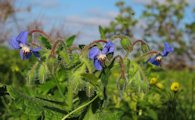 |
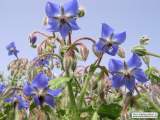 |
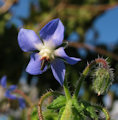 |
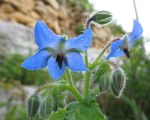 |
IMAGE: BRGOF-01 Photo of the blue flowers with white centre found hanging upside down on the plant. |
IMAGE: BRGOF-02 Photo of the flowers of the common Borage which are produced in large numbers. |
IMAGE: BRGOF-03 Close-up photo of a flower with blue petals and a white center. The black protruding structure is the anthers of the stamens arranged as a central cluster. |
IMAGE: BRGOF-04 Photo of flower with dew droplets. |
 |
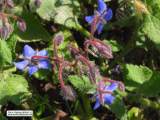 |
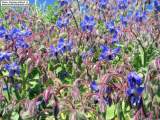 |
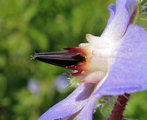 |
IMAGE: BRGOF-05 Photo of a typical plant in situ - dark green leaves with bluish flowers. |
IMAGE: BRGOF-06 Photo of flowers as seen from above (dorsal view), which clearly shows that the flowers are found hanging upside down, with their back side (dorsal part) facing up. |
IMAGE: BRGOF-07 Collection of several, conspicuous, blue flowers in situ. |
IMAGE: BRGOF-08 Closeup image of the black elongated anthers and the white central part of flower. |
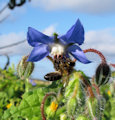 |
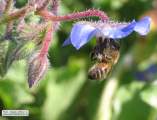 |
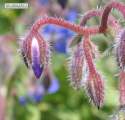 |
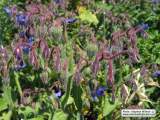 |
IMAGE: BRGOF-09 Photo of flowers to which a bee is hanging down and collecting nectar. It clearly shows that the bee utilizes the central (white) structure of the flower as a support to hold with. |
IMAGE: BRGOF-10 Another photo showing a bee holding with a hanging flower while obtaining its nectar. |
IMAGE: BRGOF-11 Close up photo of a bud in situ. The sepals are densely bristled. Bristles of sepals have a red, swollen base. 2. |
IMAGE: BRGOF-12 Photo of several buds and calices looking like hanging pot-like structures. The calyx is formed by 5 narrow free sepals. |
 |
 |
 |
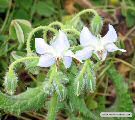 |
IMAGE: BRGOF-13 Some specimens are seen to produce pinkish flowers, or pink with blue edges. Some horticultarists stated that a variety of common borage produce pink young flowers which slowly, turns blue with time. |
IMAGE: BRGOF-14 Photo of another plant with both blue and pink flowers. Such specimens are quite rare, but quite conspicuous. |
IMAGE: BRGOF-15 Close up photo of a pink-flowered specimens of the common borage. This colou form has no significant taxonomical importance. |
IMAGE: BRGOF-16 Even much more rare is the white-flower variety as shown in this photo taken by my friend Emmanuel Schembri limits of Siggiewi/Qrendi. It is actually an 'albino' version, also indicated by the fact that the sepals and bristles also lack colour. |
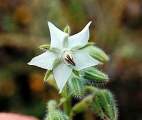 |
 |
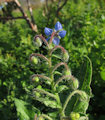 |
 |
IMAGE: BRGOF-17 Photo of a white flower variety taken from Daniel ruhlemann website ( www.ruehlemanns.de ). |
IMAGE: BRGOF-18 Photo showing the arrangement of the flowers along the stem. This type of inflorescence is called a raceme. |
IMAGE: BRGOF-19 Another photo of the inflorescences. |
IMAGE: BRGOF-20 Scanned image of inflorescence - a typical example of a raceme. Stalked flowers grow at alternate positions along the main flowering stem. Present is a leaflet growing at the opposite side of every flower stalk. |
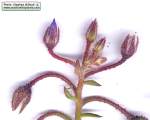 |
 |
 |
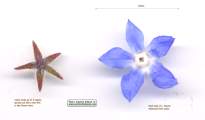 |
IMAGE: BRGOF-21 Scanned image of the upper part of the raceme having some buds at different stages of maturity. |
IMAGE: BRGOF-22 Magnified scanned image of a bud, characterized by the 5 reddish brown, (sometimes being just green) finger-like, free sepals covered with numerous white bristles. |
IMAGE: BRGOF-23 Scanned and magnified image of a flower. Each flower consists of a gamosepetalous star shaped corolla, with 5 pointed petaloid lobes, a white center and 5 black/purple stamens grouped together as a single tapering conical head. |
IMAGE: BRGOF-24 Dissected parts of flower consisting of a polysepalous calyx, (calyx made up of seperate sepals) and a flat sympetalous corolla, (made up of petals which are partly fused together) forming as a single flattened flower unit. |
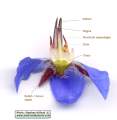 |
 |
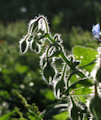 |
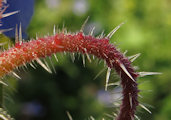 |
IMAGE: BRGOF-25 Longitudinal section of flower showing arrangement of ovaries and their style and stigma. These female flowering parts are hidden around the conical stamen group. The style is white and turn purple at the stigma. |
IMAGE: BRGOF-26 Scanned and magnified image of 2 dissected anthers. They are long, tapering, black pouches holding pale yellow pollen, seldom seen in situ. |
IMAGE: BRGOF-27 Photo of a flowering stalk and buds against light highlighting their conspicuous translucent brsitles. The plant have bristles of different sizes. |
IMAGE: BRGOF-28 Closeup photo of bristles. They often emerge from a swollen reddish base. |
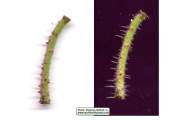 |
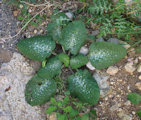 |
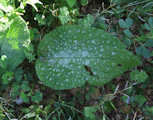 |
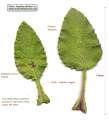 |
IMAGE: BRGOF-29 Scanned and magnified images of flower stalks, one being scanned against a dark background, to show details of the bristles. They are stiff, pointed and translucent with a swollen reddish base. |
IMAGE: BRGOF-30 Photo of large ovate leaves often ending with an auriculate or truncate base. This plant can often be identified from its leaves becasue it posses white patches at the centre and is considerably bristly. |
IMAGE: BRGOF-31 Photo of a typical basal leaf of Borago officinalis . |
IMAGE: BRGOF-32 Scanned image of two basal leaves. They have an oval shape, wavy (undulated) outline, pinnate venation and a quite long stalk. The stalk is often slightly winged and terminates with two leaf lobes clasping the stem. |
 |
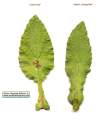 |
 |
 |
IMAGE: BRGOF-33 Scanned image of upper young leaves which are lanceolate and have a dented margin. They differ from basal leaves in being sessile (or short petiolated) and smaller. |
IMAGE: BRGOF-34 Scanned image of a basal leaf compared with a young upper leaf. Both leaves have several white bristles and pinnate venation. |
IMAGE: BRGOF-35 Photo of fruit which consists of 4 nutlets sitting on a common receptacle and enclosed in a calyx. |
IMAGE: BRGOF-36 Scanned image of fruit. The spread-out sepals in the flower will slowly close down to a oval pot shape structure, protecting the developing seeds inside. |
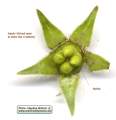 |
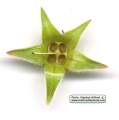 |
 |
 |
IMAGE: BRGOF-37 Scanned image of fruit with sepals forced open to show the 4 developing nutlets inside. The persistent (but now useless) style is also present at the center. |
IMAGE: BRGOF-38 Scanned image of fruit with sepals forced open after the 4 nutlets inside have ripen and dropped off. What remains is 4 empty round cavities, where the nutlets used to sit in. |
IMAGE: BRGOF-39 Longitudinal section of 2 fruit showing the developing nutlets, sepals and persistent style. |
IMAGE: BRGOF-40 Photo of mature plants already in flower during the last week of November 2010. |
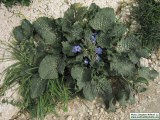 |
 |
 |
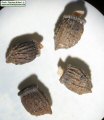 |
IMAGE: BRGOF-41 Top view photo of plant. Large dark bluish-green leaves often with pale patches and a cluster of pendulous blue flowers. |
IMAGE: BRGOF-42 Photo of several plants covering a stone wall. |
IMAGE: BRGOF-43 Scanned image of seeds - dark brown or black oval nutlets with a flat base and about 2mm x 4mm in size. |
IMAGE: BRGOF-44 Magnified image of seeds under light microscope. |
 |
| | | IMAGE: BRGOF-45 |
IMAGE: BRGOF-46 |
IMAGE: BRGOF-47 |
IMAGE: BRGOF-48 |
|
| | |

